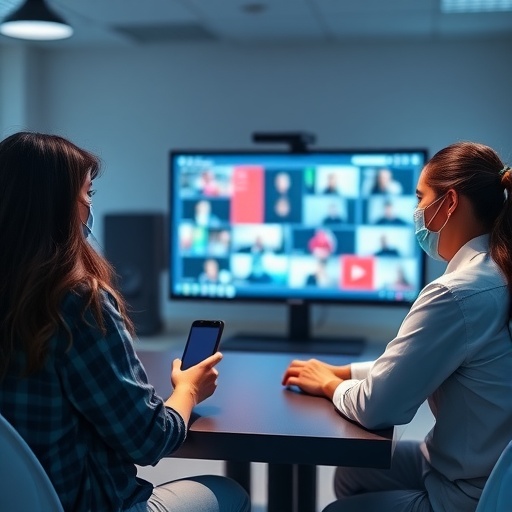The COVID-19 pandemic has profoundly altered the landscape of education, pushing institutions globally to transition from traditional in-person classroom dynamics to a predominantly online framework. This rapid shift raised questions not only about the efficiency of digital learning environments but also about how students experience online teamwork during these unprecedented times. One study that has emerged amidst this transition is authored by Dissanayake and Richards, who focus on the student perspective regarding online collaborative efforts in Australia. Their research aims to illuminate aspects of digital teamwork that educators and administrators need to consider going forward.
The study highlights that the sudden transition to online learning contexts has not come without its challenges and opportunities. Students report a mixed bag of experiences, where some thrived in a digital medium while others struggled. With social interaction becoming significantly diluted in the online realm, the ability of students to collaborate effectively has come into sharp focus. The research reveals varying degrees of comfort and adaptation among students concerning collaborative tools and platforms, amplifying the need for comprehensive support systems during and after the pandemic.
Significantly, the authors indicate that the effectiveness of online teamwork hinges largely on the perceived effectiveness of communication tools. Many students found platforms like Zoom and Microsoft Teams instrumental in facilitating interaction, yet the experience was not universally positive. Technical issues such as lagging video feeds, unstable connections, and platform malfunctions contributed to frustrations that often marred collaboration efforts. The findings suggest that schools and universities must invest in reliable technology infrastructures and provide training for students to navigate these platforms efficiently.
Interpersonally, the shift to online teamwork has compelled students to adapt their communication styles considerably. The lack of face-to-face contact has posed challenges in building rapport and fostering a team spirit. Students noted that nuances such as body language and non-verbal cues, which play integral roles in effective communication, are often lost or diminished during virtual interactions. The need for clear, overt communication has risen, where students are required to articulate their thoughts and ideas more explicitly than they would in person.
In examining the strengths of online teamwork, Dissanayake and Richards also unearthed favorable perspectives among students. Many individuals expressed that they welcomed the flexibility of online collaborations, appreciating the ability to engage in discussions outside of traditional time constraints. Students found that asynchronous communication methods, such as emails and discussion boards, allowed for thoughtful responses and deeper consideration of ideas. This aspect of online teamwork empowers students to express themselves at their own pace, potentially leading to richer contributions to group work.
However, while flexibility was mentioned as a benefit, the authors caution against the “always-on” mentality that can result from continuous connectivity. Many students reported experiences of burnout as they juggled various responsibilities in a remote setup. The blurring of boundaries between personal lives and academic obligations necessitates that educational institutions re-evaluate scheduling and workload distribution to prevent overwhelming students as they navigate online teamwork.
The emotional and mental health implications associated with online educational frameworks were also a central focus of the study. The authors discuss the role of social connection in learning and highlight that isolation felt by students can emerge when camaraderie typical of physical classrooms is replaced by digital screens. Invasive stressors, stemming from uncertainties related to the pandemic, added layers of complexity to students’ ability to connect and engage in team settings.
From a pedagogical standpoint, this research underscores the importance of faculty and instructional designers in leveraging online teamwork as a pedagogical strategy. Teachers are encouraged to explore innovative methods for facilitating group work that blends synchronous and asynchronous strategies while actively monitoring team dynamics. Continuous feedback and adaptive teaching practices can promote a culture that supports student engagement and accountable participation, all while accounting for the unique challenges that arise in an online setting.
Beyond contextualization, the authors suggest specific considerations for universities and colleges to integrate into future planning. Institutions need to prioritize workshops and seminars that elevate students’ digital literacy, encompassing technology training and communication etiquette within online frameworks. As students are groomed to collaborate successfully in virtual spaces, they require guidance to recognize the significance of collaborative skills that extend beyond academic settings to future workplaces.
Ultimately, as educational institutions reflect on the lessons learned from a tumultuous period, the results from Dissanayake and Richards provide a comprehensive glimpse into the intricate dynamics of online teamwork from a student perspective. Recognizing the nuances of individual experiences can inform better practices, turning challenges into opportunities for improvement and growth.
The study serves as an essential roadmap for future research, inviting additional investigations into not only the efficacy of online teamwork but also the psychological dimensions that accompany this mode of learning. As humanity adapts to an increasingly digital world, insights drawn from such studies will be invaluable for progressing pedagogy in a post-pandemic reality.
Envisioning the future, it is crucial for researchers, educators, and policymakers to recognize and implement strategies that empower students as they navigate the complexities of online education and teamwork. Ultimately, fostering an environment that encourages collaboration, mitigates burnout, and fosters social connection will enhance not only educational outcomes but also holistic student well-being amidst changing landscapes.
As institutions worldwide continue to grapple with the legacies of the pandemic, the need for adaptive, proactive strategies is essential. Fostering resilience among students in the ever-evolving education sector is paramount as they gear up for the future. Dissanayake and Richards have brought light to an urgent conversation that transcends geographical boundaries and emphasizes a collective responsibility to prioritize student experiences in online teamwork.
Subject of Research: Online Teamwork during COVID-19
Article Title: Online teamwork, a student’s view during COVID-19 and considerations for beyond: an Australian case study.
Article References:
Dissanayake, D., Richards, L. Online teamwork, a student’s view during COVID-19 and considerations for beyond: an Australian case study.
Discov Educ 4, 370 (2025). https://doi.org/10.1007/s44217-025-00831-w
Image Credits: AI Generated
DOI:
Keywords: Online education, teamwork, COVID-19, digital learning, student experience.




